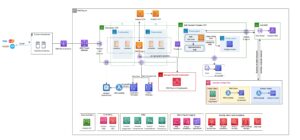To use AWS credits, simply log in to your AWS account and navigate to the Billing and Cost Management console. From there, you can apply the credits to eligible services and track their usage.
AWS credits provide a cost-effective way to explore and experiment with various AWS services, allowing you to optimize your cloud infrastructure without incurring additional expenses. By following these steps, you can make the most of your AWS credits and leverage the full potential of the AWS platform.
AWS credits offer users the opportunity to experience the benefits of Amazon Web Services (AWS) without incurring additional costs. Whether you’re a new user looking to familiarize yourself with AWS services or a seasoned user seeking to optimize your cloud infrastructure, AWS credits provide a valuable resource. We will explore how to effectively utilize AWS credits, allowing you to make the most of the AWS platform and gain hands-on experience with its vast array of services. By understanding how to apply and track your AWS credits, you can maximize your cloud computing capabilities while minimizing your expenses. So, let’s dive in and learn how to make the most of your AWS credits.

Credit: aws.amazon.com
Introduction To Aws Credits
Learn how to effectively utilize AWS credits to optimize your cloud computing costs and maximize your benefits. Explore various strategies for leveraging AWS credits efficiently in your projects and scaling your cloud infrastructure affordably.
The Concept Of Aws Credits
AWS Credits are virtual currency offered by Amazon Web Services to cover costs incurred while using their cloud services.
Users can redeem these credits to pay for their AWS usage, including services like compute, storage, and data transfer.
Benefits Of Utilizing Credits
Maximize cost savings by applying credits towards your AWS bill.
Flexibility to experiment with new services without additional costs.
Easily manage expenses by tracking credit usage through the AWS billing dashboard.
Acquiring Aws Credits
Maximize the benefits of your AWS credits by optimizing resource usage. Utilize credits efficiently to offset cloud service costs effectively.
Different Sources Of Aws Credits
AWS credits can be obtained from various sources such as events, promotions, and programs. There are numerous AWS credit programs available that offer free credits to new customers. These programs aim to encourage users to explore the AWS cloud platform and its various services. Some programs include:- AWS Activate Program for Startups
- AWS Educate Program for Students and Educators
- AWS Marketplace Free Trials
- AWS Promotional Credits
Eligibility Criteria For Aws Credit Programs
To be eligible for AWS credit programs, certain criteria must be met. Each program has its own set of eligibility requirements. For instance, the AWS Activate Program is designed for startups that are less than 5 years old and generate less than $1 million in annual revenue. Similarly, the AWS Educate Program is for students and educators who are interested in learning about cloud computing. Before applying for any AWS credit program, it’s essential to read the eligibility criteria carefully. This will help you determine if you meet the requirements and are eligible for the program. Moreover, make sure you provide accurate information when applying for the program to avoid any discrepancies. In conclusion, AWS credits offer a great way to explore the AWS cloud platform and its various services. By knowing about the different sources of AWS credits and their eligibility criteria, you can take advantage of these programs and save money on your AWS bills.Managing Aws Credits
When it comes to managing your AWS credits, it’s essential to understand how to check your credit balance, as well as the expiration and renewal policies. By effectively managing your AWS credits, you can maximize the benefits and ensure efficient utilization of the available resources.
Checking Your Aws Credit Balance
To check your AWS credit balance, log in to the AWS Management Console and navigate to the billing dashboard. Here, you can view your credit balance in real-time, allowing you to monitor your usage and plan your resource allocation accordingly.
Expiration And Renewal Policies
Understanding the expiration and renewal policies is crucial to avoid any loss of credits. AWS credits typically have an expiration date, so it’s important to keep track of the validity period. Additionally, familiarize yourself with the renewal process to ensure uninterrupted access to AWS resources.

Credit: dev.to
Strategic Allocation Of Credits
Effectively utilizing AWS credits involves strategic allocation to maximize cost savings. By carefully planning resource usage, optimizing workloads, and leveraging reserved instances, businesses can make the most of their credits. This approach ensures efficient cloud spending and allows organizations to reap the full benefits of their AWS credits.
Prioritizing High-cost Services
When it comes to using AWS credits, it’s important to prioritize high-cost services to ensure maximum savings. This means identifying the services that are essential to your business and that have the highest associated costs. By allocating credits to these services first, you can reduce your overall costs and maximize your savings.Planning Credit Usage Over Time
Planning credit usage over time is another key strategy for maximizing your savings with AWS credits. This means looking at your business needs and identifying when you will need to use certain services. By planning ahead, you can ensure that you have credits available when you need them, and you can avoid overspending on services you don’t need. To ensure that you are getting the most out of your AWS credits, it’s important to strategically allocate them. This means looking at your business needs and identifying where you can get the most value for your credits. For example, if you have credits that are expiring soon, you may want to allocate them to high-cost services that you will need in the near future.Summary
In conclusion, strategic allocation of AWS credits is essential for maximizing your savings. By prioritizing high-cost services, planning credit usage over time, and strategically allocating credits, you can reduce your overall costs and get the most value for your money. Remember to always keep an eye on your credit balance and plan ahead to ensure that you have credits available when you need them.Cost Optimization With Aws Credits
Optimize your costs with AWS Credits to maximize your cloud computing benefits. Learn how to effectively utilize these credits for enhanced cost management and increased savings in your AWS infrastructure. Gain insights on leveraging AWS Credits to optimize your cloud spending and drive business growth.
When it comes to optimizing costs with AWS, utilizing AWS credits can be an effective strategy. AWS credits are promotional funds that can be used to offset the costs of various AWS services. To make the most of these credits and maximize your cost savings, it’s important to follow certain practices. In this article, we will explore two key strategies for cost optimization with AWS credits: combining credits with cost-saving plans and monitoring and adjusting as you go.
Combining Credits With Cost-saving Plans
Combining your AWS credits with cost-saving plans can help you further reduce your overall AWS expenditure. AWS offers various cost-saving plans, such as Reserved Instances and Savings Plans, that allow you to commit to using specific AWS resources for a certain period. By leveraging these plans in conjunction with your credits, you can achieve significant cost savings.
Here’s how you can effectively combine your AWS credits with cost-saving plans:
- Identify your usage patterns: Analyze your AWS resource usage to determine which services are critical and experience consistent demand. This will help you identify the resources that are suitable for cost-saving plans.
- Choose the right cost-saving plan: Based on your usage patterns, select the appropriate cost-saving plan. For example, if you have predictable and steady usage of EC2 instances, Reserved Instances might be the ideal choice.
- Apply your AWS credits strategically: Apply your AWS credits towards the upfront payment or recurring charges of your chosen cost-saving plan. This will help you offset the costs and maximize your savings.
Monitoring And Adjusting As You Go
Monitoring your AWS usage and regularly adjusting your resources is crucial for effective cost optimization. By keeping a close eye on your usage, you can identify areas where you can further optimize costs, even when utilizing AWS credits.
Here are some best practices for monitoring and adjusting your resources:
- Set up cost and usage alerts: Configure AWS Cost Explorer to send you notifications when your usage exceeds certain thresholds. This will help you proactively address any unexpected increases in costs.
- Leverage AWS Trusted Advisor: AWS Trusted Advisor provides recommendations for optimizing your AWS infrastructure. Regularly review the recommendations and make necessary adjustments to your resources.
- Implement automation and scaling: Utilize AWS services like AWS Lambda and Auto Scaling to automatically adjust your resources based on demand. This ensures that you only pay for what you need, maximizing your cost savings.
By following these practices, you can effectively optimize costs with AWS credits and ensure that you are making the most of your promotional funds. Remember, combining credits with cost-saving plans and monitoring your usage are key to achieving significant cost reductions on the AWS platform.

Credit: www.pax8.com
Common Mistakes To Avoid
Misunderstanding Credit Applicability
Many users make the mistake of misunderstanding how AWS credits can be applied. It’s crucial to comprehend the specific services and resources to which the credits can be applied to avoid overspending.
Neglecting To Track Credit Expiration
Neglecting to track the expiration date of AWS credits can lead to wasted resources and missed opportunities. It’s essential to monitor the credit expiration date and utilize the credits before they expire to maximize their benefits.
Case Studies: Effective Use Of Credits
Optimizing AWS credits can be tricky, but with effective use, it can lead to significant cost savings. Case studies reveal the best ways to use AWS credits, including using them for reserved instances, spot instances, and other AWS services.
Startups Scaling With Aws Credits
Many startups have leveraged AWS credits to rapidly scale their operations.
These credits helped boost their infrastructure without high initial costs.
- Flexible resource allocation
- Quick scalability
- Enhanced performance
Large Organizations Optimizing Costs
Large organizations have used AWS credits to optimize costs efficiently.
They focus on cost-effective solutions for sustainable growth.
- Cost monitoring tools
- Resource utilization analysis
- Performance optimization strategies
Future Planning: Beyond Credits
Maximizing AWS credits involves strategic planning for future usage beyond the initial credit period. By optimizing resource allocation and exploring cost-effective services, businesses can extend the value of their credits and enhance long-term budget planning. Leveraging credits for training and certification programs also helps in skill development, ensuring a sustainable AWS investment.
Transitioning From Credit Reliance
It’s vital to gradually shift from relying solely on AWS credits.
Consider scaling back on resource usage to manage costs effectively.
Implement budgeting strategies for sustained financial control.
Long-term Aws Cost Management Strategies
Adopt reserved instances to secure lower prices for extended periods.
Utilize spot instances for cost-efficient variable workloads.
Implement auto-scaling to optimize resource utilization and minimize expenses.
Regularly monitor AWS usage and costs for ongoing optimization.
Frequently Asked Questions
What Can I Do With Aws Credits?
AWS credits can be used to pay for various AWS services, such as EC2, S3, and RDS. They can also be used for AWS support plans and training courses. Credits cannot be redeemed for cash and expire after a certain period of time.
How To Redeem An Aws Credit?
To redeem AWS credit, log in to your AWS account, go to Billing, select Credits, then Redeem. Enter the code and submit.
Can I Convert Aws Credits To Cash?
No, AWS credits cannot be converted to cash. They can only be used for purchasing AWS services.
How Long Do Aws Credits Last?
AWS credits typically have an expiration date, often 12 months from the date they are issued. After this period, they will no longer be valid for use. It’s important to keep track of your credit balance and usage to avoid losing any unspent credits.
Conclusion
Utilizing AWS credits can significantly benefit your business in terms of cost savings and scalability. By following best practices and optimizing your usage, you can maximize the value of these credits. Remember to monitor your usage regularly and take advantage of the various AWS services available to make the most of your credits.






